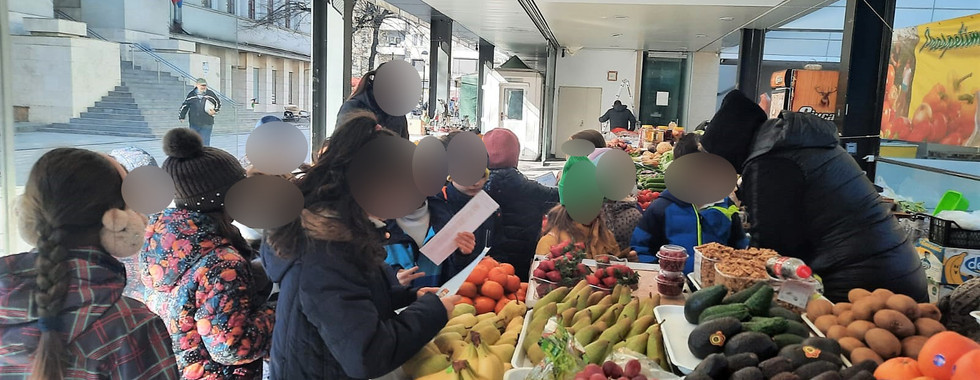
Una dintre activitățile preferate ale copiilor derulate în Săptămâna Verde a fost Micii gospodari. O activitate practică, la care au lucrat în echipe de câte patru și s-au distrat maxim. Concret, am pornit de la ideea unei alimentații sănătoase și i-am provocat să pregătească o salată de legume sau de fructe. Am rugat părinții să dea în jur de 20 – 25 RON și un tocător fiecărui copil. Eu le-am dat tacâmuri de plastic (furculițe, cuțite și câte un bol mic de plastic pentru porțiile individuale). Fiecare echipă s-a gospodărit astfel încât să aibă un bol mare de plastic pentru salata echipei. I-am mai rugat să își aducă și foarfecele, lipiciul și penarul și cam asta a fost tot.
Cum am procedat?
Pentru început, am rugat echipele să stabilească un lider care să gestioneze bugetul. Aceștia au strâns banii de la toți co-echipierii, i-au numărat și așa au știut ce sumă au la dispoziție pentru cheltuieli. Apoi le-am dat fișa cu lista de cumpărături de la Twinkl și jetoanele pentru aceasta. Toate echipele au stabilit că vor să pregătească o salată de fructe, așa că au decupat și au lipit jetoanele dorite. Pe urmă au prezentat listele în fața clasei și am discutat puțin – nu toate fructele erau în sezon în aprilie – de exemplu, nu puteau să găsească cireșe sau pepene, așa că li s-a pus în vedere să se reorienteze și să le înlocuiască cu alte fructe. Foarte interesant este că unii își notaseră sau aveau în minte cantități foarte exacte, precum 4 boabe de struguri sau 6 capșune, așa că a trebuit să le explic că nimeni nu o să le vândă căpșunele la bucată în piață, dar...
... m-am înșelat amarnic. Copiii s-au târguit cu vânzătorii din piața, au negociat cantități și prețuri și, per ansamblu, cred că au făcut piața mai bine decât o fac eu! 😊 Eu i-am dus la Piața Amzei, cea mai apropiată de școala noastră, unde erau doar două tarabe de legume și fructe, apropiate între ele, ceea ce m-a ajutat mult să am toată clasa în același loc. Copiii au învățat să urmărească o listă de cumpărături, să aleagă produse de calitate și în cantități potrivite, dar și să se încadreze într-un buget, să plătească și să primească rest. Eu nu am intervenit deloc și nici nu mi s-a cerut ajutorul, ceea ce m-a încântat foarte mult fiindcă unul din obiectivele mele este ca ei să devină cât mai independenți și autonomi cu putință.
Când am ajuns înapoi la școală, toți s-au spălat bine pe mâini, și-au spălat/decojit fructele și și-au împărțit sarcinile de lucru. Fiecare era responsabil cu pregătirea unui anumit fruct. La final, le-au amestecat în bolul mare, apoi și-au pus porții individuale și au mâncat ceea ce au pregătit. Bineînțeles, în scurt timp au început să se ducă pe la mesele altor colegi, să guste și din salatele altora. Așa că, la final, am supus la vot salatele – câștigătoare a fost cea cu mult kiwi, măr verde, banane și căpșune, cu unanimitate de voturi. La finalul activității, tot ei și-au spălat tocătoarele, bolurile și au făcut curățenie după ei în sala de clasă, lucru asupra căruia insist încă de la clasa pregătitoare.
Așadar, o activitate care:
este destul de simplă;
nu presupune costuri ridicate;
se desfășoară atât în afara școlii, cât și în sala de clasă;
facilitează utilizarea cunoștințelor (referitoare la bani, masa corpurilor și o alimentație sănătoasă) în viața de zi cu zi;
permite o experiență interactivă, copiii lucrând în echipe.
Small Farmers - Activity for Green Week or School Differently
One of the children's favorite activities during Green Week was the Little Farmers. A practical activity, which they worked on in teams of four and had a lot of fun. Basically, I started from the idea of healthy eating and challenged them to prepare a vegetable or fruit salad. I asked the parents to give around 20-25 RON and a chopper to each child. I gave them plastic cutlery (forks, knives and a small plastic bowl for individual portions). Each team brought a large plastic bowl for the team's salad. I also asked them to bring their scissors, glue and pencase, and that was about it.
How did we do it?
To begin, I asked the teams to choose a leader to manage their budgets. They collected the money from all teammates, counted it, and thus knew how much money they had for expenses. Then I gave them the Twinkl shopping list sheet and the tokens for it. All teams decided they wanted to make a fruit salad, so they cut out and glued the chips they wanted. They then presented the lists to the class and we discussed a bit – not all fruits were in season in April – for example, they couldn't find cherries or melons, so they had to substitute with other fruits . Very interestingly, some had written down or had very exact quantities in mind, like 4 grapes or 6 strawberries, so I had to explain to them that no one was going to sell their strawberries by the piece in the market, but...
... I was so wrong. The kids haggled with the market vendors, negotiated quantities and prices, and overall I think they did their shopping better than I would! 😊 I took them to Amzei Market, the closest market to our school, where there were only two vegetable and fruit stalls, close to each other, which helped me a lot to have the whole class in the same place. The children learned to follow a shopping list, choose quality products and in the right quantities, but also to stick to a budget, pay and receive change. I didn't intervene at all and I wasn't asked for help either, which made me very happy because one of my goals is for them to become as independent and autonomous as possible.
When we got back to school, everyone washed their hands thoroughly, washed/peeled their fruit and shared their chores. Each one of them was responsible for preparing a certain fruit. At the end, they mixed them in the big bowl, then took their individual portions and ate what they had made. Of course, in a short time they started visiting other colleagues' tables, tasting other people's salads. So, in the end, we put the salads to a vote - the winner was the one with lots of kiwi, green apple, bananas and strawberries, with unanimous votes. At the end of the activity, they also washed their choppers, bowls and cleaned up after themselves in the classroom, something I have been insisting on since preparatory grade.
So, overall an activity that:
is quite simple;
does not involve high costs;
takes place both outside the school and in the classroom;
facilitates the use of previous knowledge (related to money, body mass and a healthy diet) in everyday life;
allows for an interactive experience, having children work in teams.
















































Comments